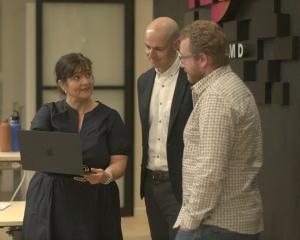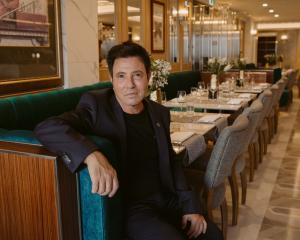
The adage "build it and they will come" does not, apparently, extend to airport runways.
Extensions to the Dunedin airport's (DIAL) landing strip is a longstanding bone of contention - and of course the question had to be asked.
"It's not currently on the radar," was the curt response.
Translated to: Coldplay may have to wait a while before they can land their 747s here.
To be fair, Pink, Ed Sheeran and the Eagles managed to wing their way to Dunedin without an elongated landing strip, generating an estimated $50million for the local economy in the process.
"We haven't been presented with any overwhelming business case for investing in runway extensions," says Dunedin Airport chief executive Richard Roberts.
He does admit, however, that it wouldn't be a stretch to add to the 1900m runway, currently rated for aircraft sized up to the Boeing 767.
"We have consent to go to 2245m and runway length hasn't really constrained our growth or that of Queenstown, which has passenger numbers over 2 million.
"In fact, unlike Dunedin, Queenstown isn't able to extend their landing capacity."
He said that contrary to the expectation of ever increasing aircraft sizes, Air New Zealand was configuring its fleet to smaller - and potentially electrically propelled - aircraft.
"Airlines are well advanced in their trials of new propulsion technologies and that will have implications for our ground and flight operations," he said.
Dunedin Airport chairman Tony Allison, who this month marked his first year as head of the DIAL board, said the company and its shareholders - the DCHL and the Crown - were comfortable with its current and planned capacity.
"Because we can do it doesn't mean we must just on the possibility that bigger planes will come."
He said the focus was rather on ensuring the runway and its airside pavement was well maintained.
"Ultimately, our operations extend well beyond our on-tarmac operations. As the gateway to the region we are part of an overall visitor economy and we put a lot of effort in working with pretty much the region's entire tourism offering, to promote Dunedin and Otago as a destination that is engineered for longer term demand."
He said DIAL was also working closely with tourism entities from Waitaki through to Southland and the Lakes region, to promote the airport's link into Queensland as a destination.
Mr Roberts admitted, however, that transtasman passenger numbers had remained under pressure and had come down nominally this past year.
"The frequency of our Brisbane services will always affect volume and our market presence, so we communicate with Virgin Australia regularly to monitor passenger numbers and to discuss potential growth opportunities on both the existing services and new Tasman services."
However, with domestic growth on an upwards cycle and expected to hit 1.7 million within the next 15 years, the airport had committed to an extensive refurbishment, spending $14 million all up on adding 1200sq m to the terminal - including a much larger security screening area - and 200 more car parks.
The new terminal is expected to be fully open by March next year.
The expansion is an important part of catering for the airport's non-aero income stream, which equates to around 58% of overall revenue, largely via retailers, parking and advertising revenue. Last year that brought in a combined $10 million, versus $7.5 million for aero-based returns.
"Ultimately, it still comes down to foot traffic, but also relates to our profile as a regional supply line into airports such as Auckland," Mr Roberts said.
"For example, our car park was at capacity and our retailers were busy this past week because of an event in Auckland, so it's not just about bringing big events into our city."
Mr Allison said the airport had also cultivated a close association with the university, and particularly the student association.
"The student market is undeniably important to us. Students are very mobile, traveling an estimated four times more than city residents and they are often event driven, so we tend to work very closely with the airlines across their campaigns - for example the take your laundry home campaign."
Outside of the terminal and parking operations DIAL's footprint is extensive, with income accruing from 29 rental homes in a housing estate adjacent to the airport as well as two 100ha farms, run by sharemilkers contracted to Fonterra.
The airport's total Momona land holdings amount to 290ha.
Says Mr Roberts: "We live and operate in a great place and we're all deeply proud of our role and place in our economy. But it's a collaborative effort. We're part of the overall offering of the city and the region, so the team does a hell of a lot behind the scenes to make sure we're tapped into the full story."
Coldplay notwithstanding.
Comments
Dunedin Airport is hardly an international airport anymore with only Virgin from Brisbane every 2nd day. And that airline is on cutbacks.
Hamilton, Rotorua & Palmy Nth all tried the international thing and failed. Tauranga & Napier were about to, but saw reality.
For nearly 4 million of the north island, there is only Auckland & Wellington.
Chch serves 600,000 people in the upper south island but also takes the southern tourist via the Mackenzie.
So with just 300,000 people of the south – we have 3 airports capable of international planes and they want a fourth!
Queenstown has done its dash and its runway far too short. The proposed Wanaka is also limited environmentally.
Invercargill has the longest runway in the south now, has room to expand, infrastructure from the adjacent city and a roading distance acceptable. Flight times from Invercargill to Auckland are pretty well the same as Queenstown & Dunedin, despite being further - so proof of having clearer skies.
Dunedin Airport is sadly too far from its city, is further to Queenstown & Wanaka by road than Invercargill, and that road is worse. A reality check is needed & to improve Dunedin would be dumb.
Dugup, a number of years back we had direct flights to Sydney for 4 months a year ( with a 85% loading factor) and Melbourne flights with a 75% loading factor. More than profitable, and since then air travel has only expanded. Take certain flights nowadays from DUD and at times half the plane seems to be connecting to an Aussie international flight from CHC, WLG or AKL. That is what I have experienced, and I fly to Oz quite a bit. I am surprised our beloved airline- Air NZ has not worked that out, or maybe they have and want to force us to "connect" through the 3 hubs- we are regions after all- we are down their pecking order.
No mention of restarting flights to Sydney and Melbourne. If we want Dunedin to be on the tourist map we need to push these flights- then we would prosper a whole more than present.
I think this article clearly articulates why the Dunedin airport is administered more like a parking lot with a runway than an actual airport. It's being run by “businessmen” rather than aviation experts. The limiting factor for expansion isn’t the length of the runway. It’s the weight-bearing capacity of the runway, taxiway & apron. Every airport has a LCG/LCN/PCN/ACN which expresses the relative load-carrying capacity of the pavement. All aircraft have a gross weight limit based upon their landing gear type (single, dual, dual tandem etc). If the aircraft gross weight exceeds the capability of the runway, taxiway or apron the aircraft can sink into it causing damage to the aircraft and/or degrade the pavement. Dunedin is a feeder airport designed to feed passengers domestically and to international departure points. The airport lacks the capacity to expand without significant investment increasing the weight-bearing capacity of the runway, taxiway & apron. This needs to be done in conjunction with the expansion of ramps, fuel storage facilities, ground support equipment, repair facilities & actual taxiways. This will never happen under the current leadership.
Agree…the powers that be need to rethink the logic in having the airport administration done by businessmen vs aviation experts. Flying out of Dunedin is very expensive. Consequently, we drive to Christchurch and fly from there. DIAL doesn’t control the cost of airfares from Dunedin but the lack of competition for AIRNZ means they have a monopoly and charge whatever they want. Robertson and Allison haven’t done anything to stimulate competition for AIRNZ. Consequently, the people of Dunedin continue to get screwed on the price of airfares. I strongly disagree that the administration of the airport is done by “businessmen”. If that were the case there would be more competition. All we have is more mediocrity!











